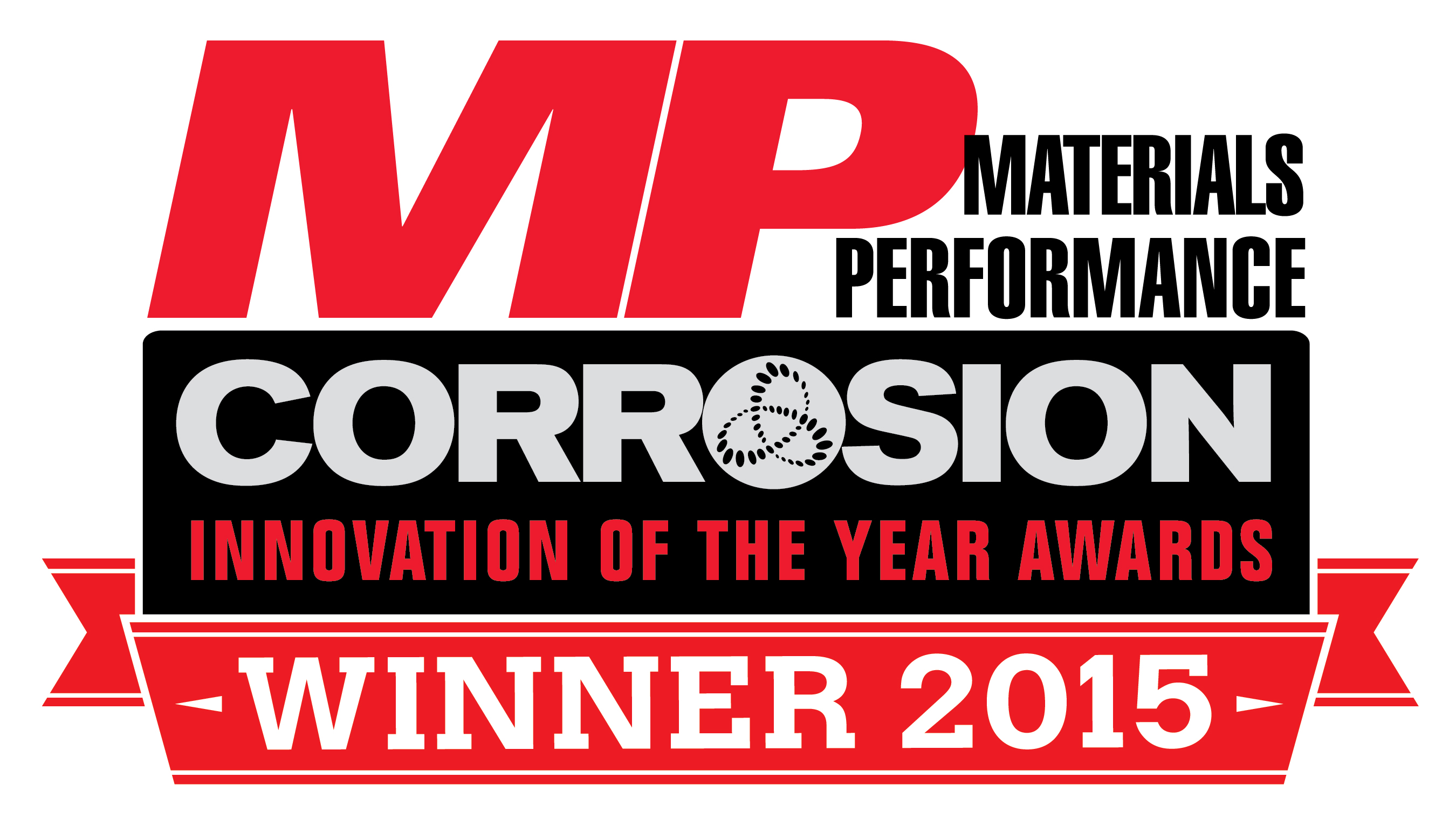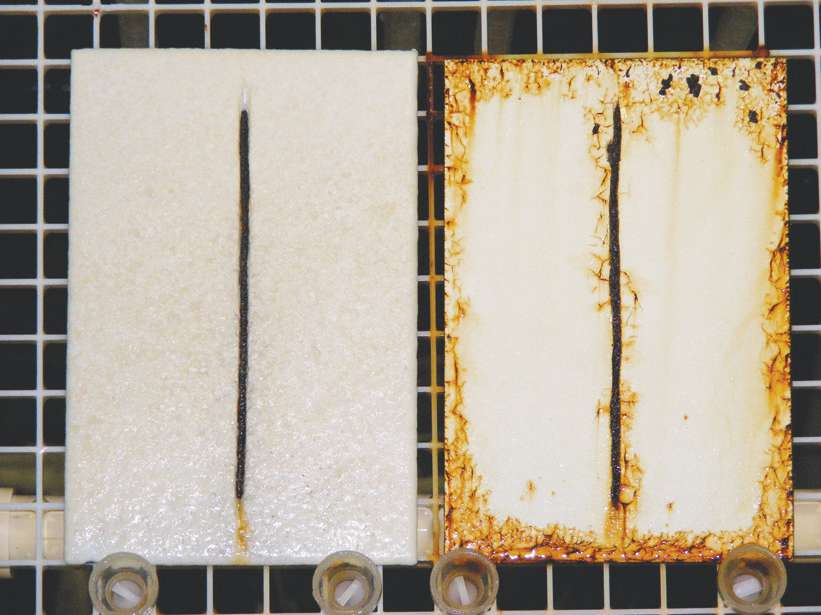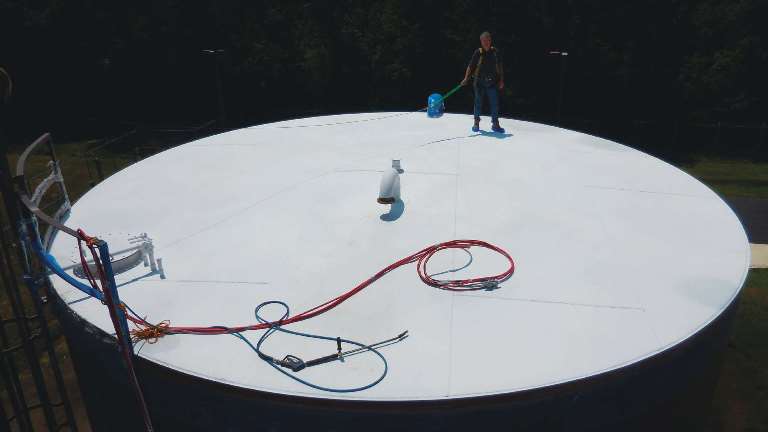
A variety of industrial facilities with structures constructed of carbon steel (CS)—from pipelines, processing equipment, to tank farms and wastewater treatment plants in global economic sectors that include oil and gas, infrastructure, utilities, transportation, production, manufacturing, and government—are at risk of corrosion. The large amounts of CS exposed to atmospheric conditions or harsh processes can be particularly susceptible. The challenge with CS is that as soon as it is fabricated, it begins to corrode. This article describes an inorganic spray-on protective coating technology developed by scientists with EonCoat, LLC (Raleigh, North Carolina) that provides corrosion protection to metal through a chemically bonded phosphate ceramic (CBPC) that bonds with the surface of a substrate to form an impenetrable ceramic. A case study is included that describes use of the coating for protection of diesel tanks. This technology is a recipient of a 2015 MP Corrosion Innovation of the Year Award.
Stopping Corrosion, Minimizing Downtime
While many industries fight corrosion due to rain, humidity, or proximity to a marine environment, some companies must combat it in harsher conditions where caustic chemicals may be present, such as the inside of some industrial storage tanks. Polymer coatings and rubber-type linings have long been used as physical barriers to keep corrosion promoters such as water, oxygen, and other aggressive substances away from steel substrates. This works until the coating or lining is scratched, chipped, or breached and corrosion promoters enter the gap between the substrate and coating, and become trapped.
“Often you can’t see the corrosion until you flake off the paint [and see] if there is corrosion under the surface,” says Bobby Hobbs, a job foreman at DC Metal Construction (Ennis, Texas), a privately owned company specializing in steel construction and industrial plant building projects.
Stainless steel (SS) resists corrosion, and tank bottoms and other equipment at high risk for corrosion are sometimes constructed of SS for that reason; however, SS can cost up to six times as much as CS. When a large wastewater treatment facility in Texas sought to control corrosion in a number of CS equalization tanks, the facility chose to have DC Metal Construction coat the tank interiors with the CBPC coating. Wastewater can be very corrosive to CS, and traditional barrier coatings cannot reliably withstand it. The CBPC coating is inorganic, so there are no volatile organic compounds (VOCs), hazardous air pollutants (HAPs), or odor. This means that the coating can be safely applied in confined spaces.
The CBPC coating technology utilizes two components—a food-grade acid phosphate and a water-based slurry that contains base minerals and metal oxides (such as magnesium oxide [MgO])—that are combined and sprayed onto a metal surface with a plural spray system. An acid-base exothermic reaction occurs at the surface of the metal, which forms a hard, two-layer ceramic coating that is chemically bonded to the metal in about 5 min. The initial application phosphates the steel in the presence of an alkali and creates an amorphous (and contiguous) layer of iron-magnesium phosphate that is less porous than the crystalline layer created by typical phosphating. This iron-magnesium phosphate barrier is chemically bonded to the steel, is highly resistant to corrosion, and is permanent. Corrosive elements cannot corrode or break through this amorphous layer.
On top of this passive layer, a 20-mil (508-µm) thick layer of ceramic made almost entirely of inhibitive pigments is formed. In the unlikely event that both the ceramic and the passive layer are breached, the ceramic layer will continually leach phosphates onto the surface of the metal. This phosphate does two things to stop corrosion and prevent further corrosion: it combines with any iron oxide to form iron phosphate, which arrests corrosion, and it also acts as a catalyst to create misawite (a hydrogen, oxygen, and iron compound). If a layer of misawite forms on the surface of steel, it creates a barrier that reduces the rate of further corrosion by many orders of magnitude. This self-healing feature makes it virtually impossible for corrosion promoters such as oxygen and moisture to penetrate the coating. The ceramic shell resists corrosion, fire, water, abrasion, chemicals, and temperatures up to 400 °F (204 °C).
“Unlike traditional methods, the corrosion- resistant coatings for mild steel have a double layer of protection,” says Hobbs. “The tough, outside ceramic coating will not chip like paint and takes sandblasting to remove. The chemically bonded layer stops corrosion and will not allow corrosion promoters to spread.”
The CBPC coating has been rigorously tested by independent third parties. It has undergone thousands of hours without corroding in an ASTM B1171 salt spray test. To determine how the coating would perform under a more aggressive corrosion test, a CBPC-coated steel sample, gouged down the center with a scribe, was tested for corrosion resistance using a seawater corrosion test developed by NASA. The test consists of continuous cycles of four hours of exposure to seawater spray (an average of 14 gal [53 L] of seawater are sprayed on the samples) followed by four hours of exposure to simulated sunlight (426-nm light waves) in a test chamber.

Additionally, NASA performed 18 months of outdoor testing on the CBPC coating at its Corrosion Testing Lab at Kennedy Space Center, Florida as part of the first stage of a validation project for environmentally preferable coatings for its launch facilities. The coating advanced to the second stage of the validation project. The coating was also included in testing by the Edison Welding Institute for the Federal Railroad Administration (FRA) Rail Base Corrosion and Cracking Prevention study.2
After experiencing good results with the coating in the CS equalization tanks, DC Metal Construction coated the inside of a clarifier tank at the Texas wastewater facility as well. “In the five steel tanks we have sprayed…in the past six years, we have had no corrosion issues, and no need for patching,” says Hobbs. “From the results we are getting, I believe the corrosion-resistant coating can add decades of low-maintenance, usable life to carbon steel tanks and other structures.”
The CBPC coating is applied as a single- coat system using a two-part spray gun. Heating the material as it is sprayed is not required. The coating dries to the touch in 5 to 10 min and cures in about an hour. “After appropriate tank preparation, we found that if we spray…in the morning, the tank can be returned to service the same day because it applies in one coat and dries quickly,” says Hobbs. “Quick return to service like this can be particularly important in production-focused industries like oil and gas. Since the corrosion-resistant coating has no VOCs, HAPs, or odor, we were able to spray during work hours, so the facility could stay in full production in adjacent areas while we coated the tanks,” he adds.
Case Study—Merck Pharmaceuticals
The aggressive production schedule of Merck Pharmaceuticals requires that production facilities be powered at all times and fully operational. To achieve this, Merck uses large tanks filled with diesel fuel to power generators that feed the facility. Merck had used a traditional three-part system of inorganic zinc, epoxy, and urethane to coat the fuel tanks, which eventually showed signs of corrosion.

To prevent the costly time loss of repeated paint applications, Merck chose the CBPC coating with a topcoat to protect its assets and provide an environmentally sound corrosion-resistant solution. What is typically a two-week job to coat the tanks was shortened to five days. The surface preparation was less time consuming, flash rust did not need to be removed, and there was no need to wait for the coating to dry overnight prior to applying a topcoat. The application occurred in June 2014 when temperatures exceeded 95 °F (35 °C) in direct sunlight.
Source: EonCoat, LLC; Web site: eoncoat.com.
References
1 ASTM B117, “Standard Practice for Operating Salt Spray (Fog) Apparatus” (West Conshohocken, PA: ASTM International).
2 “Rail Base Corrosion and Cracking Prevention,” U.S. Department of Transportation Federal Railroad Administration, DOT/FRA/ ORD-14/27, July 2014.